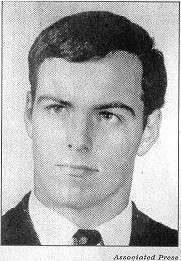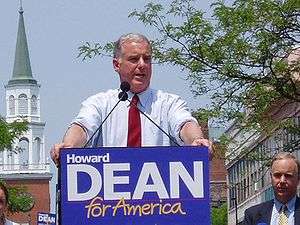Charles Dean

Charles "Charlie" Dean (died 1974 at age 24) was the brother of Democratic National Committee Chairman Howard Dean; Democracy for America Chairman Jim Dean; and political activist Bill Dean. In 1974, Charlie, had been traveling through southeast Asia at the time with Australian journalist Neil Sharman (23). The two were captured and killed by the Communist Pathet Lao guerrillas. Their deaths attracted wide and ongoing attention.
Although a civilian, Dean was regarded by the United States government as a prisoner of war.[1]
On November 14, 2003, the remains of Charles Dean were repatriated to the United States, and those of Neil Sharman were repatriated to Australia.[2][3]
Dean
Dean grew up in Manhattan and worked summers as a volunteer counselor with Boys Harbor.[4]
Charlie graduated from the University of North Carolina at Chapel Hill where he was active in student government and the anti-war movement in 1972.[5][1] In 1972, he went on to work as the Orange County, NC coordinator for Democrat George S. McGovern's 1972 presidential campaign.
In 1973 Deal traveled to Japan by freighter, then on to Australia where he worked on a ranch for 9 months.[5] While there he met Australian journalist Neil Sharman.[5]
In 1974, the two traveled to Laos to visit a friend of the Dean family who worked for USAID. Together with Sharman, Charlie stayed in a bungalow on the Mekong River, planning to meet up with another friend who was serving in the Peace Corps in Nepal.[5]
In early September 1974, Charlie and Neil took a raft down the Mekong River to Thailand.[6] They were stopped at a checkpoint near a small village called Pak Him Boun, two miles southeast of the capital of Laos, Vientiane, by Pathet Lao communist guerrillas who imprisoned the two, apparently because they were carrying cameras.
Dean's parents traveled to Laos where they met with Primier Souvanna Phouma and Prime Minister Prince Souphanouvong in May 1975 in an effort to obtain the release of Dean and Sharman.[7]
The U.S. government demanded the release of both Dean and Sharman.[8] Charlie was classified as a POW-MIA although he was a civilian. Charlie and Neal were executed by the Pathet Lao on or about December 14, 1974.
A memorial service was held for Dean at St. Luke's Episcopal Church in Easthampton, New York, in the year following his death.[9]
Sharman
Neil Sharman, was a young Australian who had previously worked as a journalist for the Sydney Morning Herald was working for the Northern Territory News when he wrote to tell his brother in 1973 that he was taking a backpack and heading off ot see "Indonesia, Malaysia, India and all places in between. Maybe the Arab countries (If we can without being shot)."[10] [11] Sharman's girlfriend, Joy Hooper, who had been traveling with the two men, searched desperately for information on the two, questioning government officials across the region for several fruitless months before returning home to Australia.[12]
Execution
Examination of the remains showed that the two young men has been handcuffed and executed.[13]
Legacy
In 2000, through accounts given by people who had seen the two young men killed, the site where Charlie and Neal were believed to have been buried was located.
On November 11, 2003. Howard Dean confirmed that a joint U.S.-Laotian task force had likely discovered the remains of his younger brother, and DNA analysis subsequently confirmed that the remains were Charles Dean’s.[14]
In May 2004, Charles Dean’s remains were buried with his three brothers and his mother in attendance.
Charlie's death has been widely reported by Howard Dean as having had an enormous influence on his life; such that he wore his brother's belt every day of his presidential campaign.
References
- 1 2 "Pentagon Recovers Remains Believed to Be Howard Dean's Brother". Fox News. AP. 18 November 2003. Retrieved 14 November 2016.
- ↑ US returning remains of war victims: [1 State Edition] The Daily Telegraph (Australia) 24 November 2003.
- ↑ "Laos returns Westerners' remains". BBC. 24 November 2003.
- ↑ Friend Recalls Young Deans, Ellis Henican, Newsday, 10 Dec 2003: A04.
- 1 2 3 4 Squitieri, Tom (19 November 2003). "Laos remains may be of Dean's brother". USA Today. Retrieved 14 November 2016.
- ↑ Wilgoren, Jodi (27 November 2003). "Dean Pauses to Reflect on a Brother's Long Trip Home". New York Times. Retrieved 14 November 2016.
- ↑ "Notes on People; Kissinger Fills In for His Wife". New York Times. 13 May 1975. Retrieved 30 November 2016.
- ↑ "Shelling at Hue". Washington Post. 3 December 1974. Retrieved 30 November 2016.
- ↑ "Rites for Charles Dean, 24, Missing in Laos Last Year". New York Times. 28 May 1975. Retrieved 30 November 2016.
- ↑ Whittaker, Mark (29 May 2004). "Wartime puzzle comes to sad end". The Australian. Retrieved 14 November 2016.
- ↑ Jameson, Neil (11 April 2014). "Neil Sharman; journalist who disappeared in Laos, 1974". The Newcastle Herald. Retrieved 14 November 2016.
- ↑ Keavney, Kay (26 March 1975). "Australian Girl's Exclusive Love Story". The Australian Women's Weekly. Retrieved 30 November 2016.
- ↑ "Grim find solves mystery". Herald Sun. 19 November 2013. Retrieved 14 November 2016.
- ↑ Jodi Wilgoren and Michael Slackman (November 19, 2003). "Remains of Dean's Long-Missing Brother Found". New York Times. Retrieved 2014-07-27.
On Tuesday, Dr. Dean, who rarely mentions his family on the stump, interrupted his schedule to announce that a search team had found his brother's remains buried in a rice paddy in central Laos. ...
Further reading
- Dr. Howard Dean, Winning Back America (Simon & Schuster, 2003) ISBN 0-7432-5571-2.

